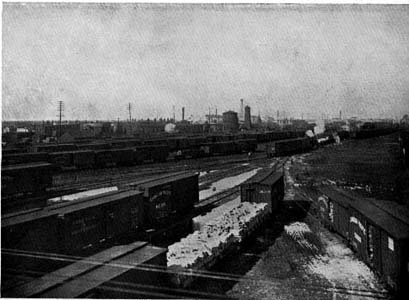Search | Image Archive | Reference | Communities | POV | Lesson Plans | Credits
 Just after the First World War, there were about ten thousand railway workers in yards and workshops across Winnipeg. The operations of the railway were large and complex and required a variety of skilled workers as well as hundreds of labourers to maintain the rails, engines and cars, to load and unload freight, operate the trains, and handle the huge volume of people that passed through the city's two major passenger terminals.
Just after the First World War, there were about ten thousand railway workers in yards and workshops across Winnipeg. The operations of the railway were large and complex and required a variety of skilled workers as well as hundreds of labourers to maintain the rails, engines and cars, to load and unload freight, operate the trains, and handle the huge volume of people that passed through the city's two major passenger terminals.
Much of the maintenance of engines and rolling stock was performed at the shops in the Canadian Pacific Weston Yards, which separated South Winnipeg and the West End from the North End. The Weston shops were a hub of industrial activity. Workers there repaired and maintained the company's engines, built and repaired rolling stock, and even forged and manufactured the rails themselves. To accomplish this, the Shops employed workers with a wide range of skills.
In the 1890s, highly skilled workers in apprenticed trades, like pipefitters, welders and machinists had organized themselves into craft unions. During the First World War, these craft unions organized themselves under the Metal Trades Council to improve their bargaining power.
Craft unions were élite organizations, and they defined themselves through the exclusion of unskilled and semi-skilled workers. Union leaders among the metalworkers like R.B. Russell and R.J. Johns began to advocate for industrial unionism. They argued that the rigid craft structure allowed some workers to benefit from the poverty of others, and that a more inclusive form of unionism where everyone in a shop was represented by the union would give the workers, skilled and unskilled, more power.
At the time of the Winnipeg General Strike in 1919, Russell and Johns were organizing members of the Metal Trades Council to create just such a union, and one affiliated with the One Big Union (O.B.U.), a pan-industrial union which dreamed of organizing all workers under one body.
Page revised: 29 August 2009